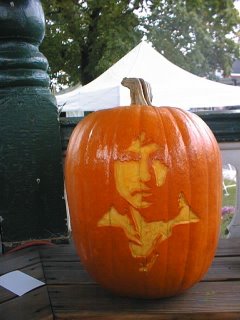 One of the (many) joys of doing Dreamtime is the feedback from listeners/readers. I'd do it anyway :-), but hearing that people really enjoy the podcast is an added benefit. And sometimes you even hear from one of your heroes...
One of the (many) joys of doing Dreamtime is the feedback from listeners/readers. I'd do it anyway :-), but hearing that people really enjoy the podcast is an added benefit. And sometimes you even hear from one of your heroes...
Dickie "Be-Bop" Harrell - the original drummer for Gene Vincent's Blue Caps - recently dropped me a line, complimenting me on my story about Tommy Facenda (Episode 16 – "Gene Vincent said, 'Bubba, let's go on tour'") and passed on a reunion photo of the Blue Caps. Click on the photo for a larger version.
From Left to Right: Johnny Meeks, guitar; Tommy "Bubba" Facenda, vocals, clapper; and Dickie "Be-Bop" Harrell, drums.We used to play these shows in the beginning; we had George Jones and Carl Perkins and Roy Orbison and different ones and this and that. We played shows with Johnny Burnette. And at that time, when we were doing all this stuff for them, the big thing for them was just to go out there and do their thing. But hell, we'd go out there and act stupid and fall all over the damn place and jump in the audience and run up and down the aisles and all that. They'd just sit around and look and just think you lost your damn mind! - Be-Bop Harrell
Rockabilly gods. Thanks for writing, Be-Bop! And thanks to all my listeners and to everyone who has written in. The staff of Dreamtime - Jailbait, Curly, Bear, and Your Host wish you a happy and safe New Year. More Dreamtime coming in 2007!
Visit the Dreamtime Store
Saturday, December 30, 2006
Best wishes for the New Year from Your Station Manager
Posted by
Fred@Dreamtime
at
2:12 PM
0
comments
![]()
Labels: A Message From Your Host, Blue Caps, Dickie "Be-Bop" Harrell, Gene Vincent, Johnny Meeks, Tommy Facenda
Friday, December 29, 2006
Episode 24: 1953 and Changes in the Wind
 [Intro]
[Intro]
Direct link to mp3.
Subscribe to Dreamtime
Episode 24 - 1953 and Changes in the Wind

Dreamtime closes out 2006 with a turn around the radio dial and a look back at a year when music was about to change forever... 1953.
Harry S. Truman hands over the reins of power to Eisenhower. Peter Pan and the first 3D movie, Bwana Devil, premieres. Ian Fleming publishes the first James Bond novel, Casino Royale. Both the U.S. and Soviet Union announce the development of a hydrogen bomb.
The Korean War ends and the Kinsey Report issues Sexual Behavior in the Human Female. Pat Benatar, Desi Arnaz, Jr., Cyndi Lauper, Alan Moore, and Kim Basinger are all born in 1953.
On January 1, 1953, Hank Williams hired a chauffeur to drive him to his next gig in Canton, Ohio from Knoxville, Tennessee. Williams left in a Cadillac, carrying a bottle of whiskey with him. When his driver pulled over at an all-night service station in Oak Hill, West Virginia, he discovered Williams dead in the back seat. Hank Williams was 29.
Williams' single, the eerily-titled I'll Never Get Out of This World Alive would hit #1 on the Billboard Country Charts on January 24, 1953, and is our first stop in our spin around the 1953 airwaves.
 As Dylan says in the Dogs episode of Theme Time, Patti Page's (How Much Is) That Doggie in the Window? - which she recorded on a Thursday, the week before Christmas, a date which also happens to be the date of my birth, December 18, 1952 - would hit the top of the single charts on January 10th, 1953, and remain there until finally booted off by Percy Faith and his Orchestra's Song From Moulin Rouge, also known as Where is Your Heart?
As Dylan says in the Dogs episode of Theme Time, Patti Page's (How Much Is) That Doggie in the Window? - which she recorded on a Thursday, the week before Christmas, a date which also happens to be the date of my birth, December 18, 1952 - would hit the top of the single charts on January 10th, 1953, and remain there until finally booted off by Percy Faith and his Orchestra's Song From Moulin Rouge, also known as Where is Your Heart?
In turn that single would lose the #1 slot to I'm Walking Behind You, sung by Eddie Fisher. Turn on your Dreamtime radio and listen in as we broadcast a collage of popular music from January through June of 1953, including all three, as well as Perry Como's Don't Let the Stars Get in Your Eyes, the first #1 pop single of 1953.
But change, as the man says, was in the wind.
Crazy Man, Crazy, recorded by Bill Haley & His Comets in April 1953, would be the first rock and roll single to make it on the American musical charts, where it peaked at #12. Crazy Man, Crazy may also have been the first rock and roll recording to be played on national television in the U.S. when it was used in the soundtrack of Glory in the Flower, an episode of the CBS anthology series, Omnibus. Interestingly. Glory in the Flower starred James Dean, soon to become iconic in Rebel Without a Cause.
On August 1, 1953, The Orioles' biggest hit, Crying in the Chapel, enters the R&B charts, and will go on to top the charts for the next eight weeks. A decade later, Elvis Presley would cover Crying in the Chapel for his gospel album How Great Thou Art. And Elvis, as Dylan says, would begin his Sun recording career in the summer of 1953, most likely prompted by an article in the local paper on Sam Phillips's recording of the Prisonaires, a group of prisoners from the state penitentiary, as faithful Theme Time listeners already know.
Elvis walked into into 706 Union Avenue and asked to record for the very first time. The two songs he cut were My Happiness, originally written in 1933 by Betty Peterson and Borney Bergantine and That's When Your Heartaches Begin, written in 1940 by William J. Raskin, Billy Hill and Fred Fisher. Elvis later re-recorded that one for RCA as the B side to the single All Shook Up and it peaked at #58 on the Hot 100 Chart...
...and meantime, back in 1953 the doggie was growing up to be a hound dog. We wind up our Dreamtime radio tour with Big Mama Thornton's original 1953 version of Hound Dog, written Jerry Leiber and Mike Stoller. Big Mama Thornton is backed on this cut by by Theme Time favorite Johnny Otis, who also got author credit on the original pressings.
You've been listening to the Dreamtime podcast – occasional commentary on Bob Dylan's Theme Time Radio Hour.
Dreamtime is researched and written by Fred Bals, and is a Not Associated With production.
Some of the music on Dreamtime is provided via the Podsafe Music Network. Check it out at music.podshow.dot com. Our closing theme is performed by Lounge Affaire, courtesy of Christopher Murphy Studio.
We love your email and you can write us at dreamtimepodcast@gmail.com
The Dreamtime top cats are Curly Lasagna and Shaggy Bear. Our announcer is the lovely Jailbait Jones.
Until next time, dream well.
Posted by
Fred@Dreamtime
at
1:09 PM
0
comments
![]()
Labels: Big Mama Thornton, Dogs, Elvis Presley, James Dean, Johnny Otis, Patti Page
Saturday, December 09, 2006
Episode 23 - In Search of Eddie G.

[Intro]
Direct link to mp3.
Subscribe to Dreamtime
Episode 23 - In Search of Eddie G.
["Here Comes Eddie" - The Eddie G. Singers]
With the Christmas season coming up, it seemed like the right time to take another* look at the producer of "Theme Time," Mr. Eddie Gorodetsky, better known to his fans as "Eddie G."
"Eddie G. has fans?" you say. "And what does he have to do with Christmas?"
Glad you asked.
I mentioned in that earlier show that Eddie was a writer for TV shows such as "Dharma & Greg," "Saturday Day Night Live," the animated Batman series, and various Penn & Teller specials. He also writes liner notes for CDs - which almost appears to be a second career for the man. But Eddie G. may be best known among a small, select circle for his annual holiday mix tapes.
Starting sometime in the early 1980s, Eddie G. began circulating Christmas mix tapes on cassette to family and friends. The tapes were a compilation of weird, strange, forgotten, and sometimes very cool Yule tunes, culled from 45s, albums, and promotional tapes from Gorodetsky's collection; reportedly one of the largest privately-owned Holiday Music collections in the world. By 1999, he was sending out over 1500 copies of his Christmas mix tapes.
In 1990, Columbia released a commercial CD version of Eddie's annual tape mix titled, "Christmas Party with Eddie G." Now out-of-print, but regularly available on eBay. "Christmas Party with Eddie G." could almost be an episode of "Theme Time" with tracks featuring The Skeltons, Louis Prima, Huey "Piano Smith" and the Clowns, Rufus Thomas, and George Jones and Tammy Wynette among others.

One of the very interesting things about "Christmas Party with Eddie G." isn't the music, but the label. I mentioned that Columbia issued it. Actually that isn't quite right. The disc is a "Columbia publication," under the "Strikin' It Rich" label. Strikin' It Rich was created in October of 19 and 90 with the reported goal of "releasing rare and interesting rhythm and blues material."
And who was behind "Strikin' It Rich"? Our Host, Bob Dylan.
"Christmas Party with Eddie G." was apparently the only disc ever released under the Strikin' It Rich imprint. When the disc was re-released in 1998, it came out under the Columbia/Legacy brand.
Not to re-open the debate which broke out about how much involvement Dylan actually has with "Theme Time," but my research makes me increasingly of the opinion that Gorodetsky plays a major role in the creation of "Theme Time," which would make sense, since that's what a "producer" does after all.
I think Dylan is much more than just a voice talent or the name they needed to make "Theme Time" work, although "Theme Time Radio Hour with Your Host, Eddie G." would have had a much smaller audience. A read through Chronicles is pretty clear evidence that many of the "Theme Time" selections are coming directly from Dylan's input. But the man also released a record album in 2006, just finished a major U.S. tour and is now blasting his way through Europe and (I hope) is working on the second volume of Chronicles and God knows what all. It's hard to think he's hauling his record collection along on the bus, or calling home and saying "Will you FedEx out that 78 of 'I Heard The Voice Of A Pork Chop'" for me? I think the last time I saw it was on the kitchen shelf."
I wonder if the scenario at the Abernathy Building when Lee Abrams was finally able to set up a meet with Dylan and "his people" went something like someone on Dylan's side saying, "Y'know, we should get Eddie G. in on this. This is like what we were trying to set up with Strikin' It Rich, but even better, 'cause it's radio! Eddie knows as much about Ol' Weird America music as Bob does, and their tastes run the same."
And now there's some brainstorming every couple of weeks when the next Themes get picked and Eddie and Bob swap playlists and take stuff off and put stuff on until they get something down they like, and the licensing and permission teams of Diane and Debbie go to work and the research team hits Wikipedia for some color and Bob does his commentary and Eddie keeps all the other plates spinning and the balls in the air in order to produce a weekly hour-long radio show.
Who knows? But it's fun to speculate. And I sure wish I had been a fly on the wall when they were setting this up.
So, who is this man, Eddie G. What more do we know about him?
"I started collecting records in high school, in the early 1970's," said Gorodetsky in an interview for CollectorMania!. "I grew up in Providence, Rhode Island, and I remember hearing legends about record stores in Boston that have bins full of these records that you couldn’t find anywhere, and I remember hitchhiking with a couple of friends of mine up to Boston more than once to go to stores in Roxbury and Boston. I ended up living in Boston and working in a half-dozen record stores there."

In the late `70s, Eddie also worked as a columnist for the Boston Rocks music fanzine, and occasionally as DJ for WERS-FM , doing a rhythm and blues show called, "Real Oldies."
A bogus posting, maybe from Eddie G. himself, on a J. Geils Band message board claims that he was also an M.I.T. post-grad, working on a study of earthworms and their reaction to rock and roll, particularly of the J. Geils Band's music. Earthworms aside, Eddie G. was tight with several of the band members, especially Peter Wolf, and would appear on Wolf's solo album "Light's Out" after the breakup of The J. Geils Band. Here's Eddie G. as the radio announcer from Peter Wolf's "Mars Needs Women."
[Mars Needs Women excerpt]
As I noted in my opening, Eddie G. has also worked on several Penn & Teller specials. Penn Jillette calls Eddie, "one of the funniest guys in the world." coming up with up with the idea for a proposed Penn & Teller videogame for people who didn't like violence, "Desert Bus."
The goal of Desert Bus was to drive a bus from Tucson, Arizona to Las Vegas, Nevada, a very long, boring drive, since your bus could not go over 45 miles per hour, and nothing happened. You simply saw desert scenery.
 The bus' steering was also slightly out of alignment, meaning the player had to be on the controller at all times. And, the game happened in real time, and couldn't be saved. The only way a player could win was to drive the whole trip in one session. One eight hour plus session.
The bus' steering was also slightly out of alignment, meaning the player had to be on the controller at all times. And, the game happened in real time, and couldn't be saved. The only way a player could win was to drive the whole trip in one session. One eight hour plus session.
Rumor had it that if you accomplished the eight-hour trip and made it to Vegas you scored... one point.
"Desert Bus" was never officially released but bootleg copies of the game can still be found on the Web. Another legacy from Mr. G.
If you do a deep enough search, you'll eventually find references to the ubiquitous Eddie everywhere, including cartoonist's Paul Dini's site detailing the adventures of Santa Claus' daughter, Jingle Belle.
including cartoonist's Paul Dini's site detailing the adventures of Santa Claus' daughter, Jingle Belle.
"The coolest elf at the North Pole," , says Jingle in her description of Eddie the Music Elf. "[He] has the biggest record collection this side of Greenland. True, a lot of it is Xmas music, but a surprising amount of it does not suck. If you want a great ska version of "Frosty" or a hot zydeco rendition of "Sleigh Ride" Eddie’s the man to see. Each year Eddie descends into his subterranean subarctic Xmas record vault to blend the familiar, the obscure and the just plain weird into a holiday mix."
Writer, musicologist, Mix Master, cartoon character, game inventor, radio producer, Eddie G. seems to have re-invented himself as many times as Bob Dylan himself. Where he'll appear next, no one knows, but whatever he does next, you can bet it will be interesting.
["So Long Eddie" - The Eddie G. Singers]
This had been Fred Bals with the Dreamtime podcast – occasional commentary on Bob Dylan's Theme Time Radio Hour. Dreamtime is a Not Associated With production, and indeed, is not associated with much of anything. Special thanks to the contributors at the Theme Time message boards. Dreamtime's opening segment provided by Jailbait Jones. Background music for this podcast was provided by Kimo Watanabe, via the Podsafe Music Network. Our closing theme is performed by Lounge Affaire, courtesy of Christopher Murphy Studio.
Until next time, dream well.
*Dreamtime's first look at Eddie G. can be found here.
Sources: The J. Geils Band Message Board; A Christmas Yuleblog; Doo-Wop Around the Christmas Tree; Whistle Bait: 25 Rockabilliy Raveups; Interview with Paul Dini; Penn Jillette discusses unreleased game; CollectorMania! - When L.Ps.s Roamed the Earth (Acrobat document)
Posted by
Fred@Dreamtime
at
11:46 AM
2
comments
![]()
Labels: Debbie Sweeney, Desert Bus, Dharma and Greg, Diane Lapson, Eddie Gorodetsky, Kimo Watanabe, Penn Jillette, Ukulele
Monday, November 27, 2006
Episode 22 - All Along the Watchtower
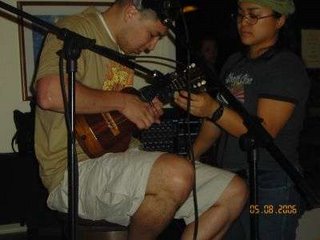
Direct link to mp3.
Subscribe to Dreamtime
[Intro]
Episode 22 – All Along the Watchtower
This is another one of the shows that decided to write itself, and I'm just along for the ride. I'm a regular listener of Brian Ibbott's Coverville podcast, which I commend to your attention if you haven't heard it. As the name implies, Coverville focuses on cover music, sometimes centered around a particular artist or band, sometimes just a hodge-podge of different covers that have caught Brian's ear.
Back in October, in one of those hodge-podge shows, Coverville 'casted a stark, spooky cover of Dylan's All Along the Watchtower played on ukulele – yes, ukulele - by a musician named Kimo Watanabe. I finally got around to listening to that podcast in November and when I heard it, the music literally made me pull over to the side of the road so I could focus on listening.
It's what radio is all about, and doesn't happen often enough anymore. Thanks to the wonders of these here internets, I was able to track down Kimo – who has a Myspace page – sent off an email, and he responded with not only a new version of All Along the Watchtower, but several other pieces of music from the album he's currently working on, Backyard Music. Here's Kimo Watanabe with All Along the Watchtower.
[All Along the Watchtower]
Dylan recorded All Along the Watchtower in 1967, releasing it on John Wesley Harding, his first album after the famous motorcycle accident. At least 30-odd – and probably many, many more than that - bands and musicians have covered the song ; everyone from Elton John to the Kronos Quartet's semi-classical take on the song, to, of course, probably the most famous cover of them all, Jimi Hendrix's version. In fact, the cover may be better-known than Dylan's original. Many people on first hearing it – including my then 13-year-old self – assumed Hendrix had written it.
As the story goes, Hendrix heard the song at a party and the same night went into the studio to record it, backed by Traffic's Dave Mason. Released as a single, it was Hendrix's only U.S. Top 40 hit, making it to #20 in 1968.
I've always thought of All Along the Watchtower as an October and November song; an end of days song, characters trying to stay warn on a bleak wind-whipped tower, snow falling around them, the watchfire embering, and in the distance two figures on horseback approaching, their purpose unknown. Friends? Heralds of an approaching disaster?
These days All Along the Watchtower is a regular war horse in Dylan's encore stable; at my rough count he played it over 60 times during his 2006 tours, thundering it out at the encore close of his shows, the reverse side of the cynical optimism of his other regular encore song, Like A Rolling Stone. If Like a Rolling Stone has become something of the anthem for `60s survivors, All Along the Watchtower may be their elegy. No one is being asked how they feel at world's end.
This is Fred Bals with the Dreamtime podcast, occasional commentary on Bob Dylan's Theme Time Radio Hour, occasional commentary on other things Dylan-related. If you're listening to Dreamtime through iTunes or an RSS Reader, please come by and visit our home page Just put Dreamtime podcast in Google, Yahoo, or whatever your favorite search engine, and we'll be number one on your hit parade.
And if you can't get enough of that good old Theme Time music, take a look at the left-hand column for the Dreamtime Store, where you'll find Amazon links to the music and artists featured on "Theme Time." I have three sections up – Flowers, Mothers, and Weather – and will be creating more as soon as I can.
Closing us out is another cover from Kimo Watanabe, his take on that jazz classic, "The Way You Look Tonight."
[The Way You Look Tonight]
Podcaster or listener, you can find even more of Kimo's music for your pleasure at the Podsafe Music Network.
Visit the Dreamtime Store
Posted by
Fred@Dreamtime
at
4:23 PM
1 comments
![]()
Labels: All Along the Watchtower, Jimi Hendrix, Kimo Watanabe, Ukulele
Thursday, November 16, 2006
Episode 21 – Def Poets Society
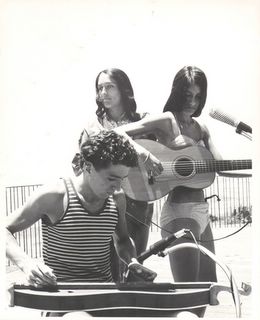
Direct link to mp3.
Subscribe to Dreamtime
[Intro]
Be quiet now and still. Be unafraid:
That hiss and garden tinkle is the rain,
That face you saw breathe on the windowpane
Was just a startled cat with eyes of jade –
Cats worry in the rain, you know, and are afraid.
The nervous laugh that creeps into our room
Is throated in a voice beyond the door.
We hear it once and then no more,
A distant echo tumbling from its loom.
Our time is measured in another room.
We know days pass away because we’re told.
We lie alone and sense the reeling earth.
(You whisper in my ear it has some worth)
And I lean near to keep you from the cold.
There are so many things that must be told.
I speak of lost regimes and distant times,
And afternoons of rain spun into rhyme.
(The patter of the rainfall marks our time.)
As does the waning moon. Or muted sun.
As do the nodding gods who ride the sea.
For even now, alone and still with me,
You sense the bonds that cannot be undone:
Our pulse is in the rain and moon and sun,
We take our breaths together and are one.
Celebration for a Gray Day - Richard Fariña
Put away your themes and schemes, because it's time for the Dreamtime podcast, occasional commentary on Bob Dylan's Theme Time Radio Hour. In the background is Tommy Flanagan's, "Peace," and today we're taking about poetry…
I have to admit that when I first heard Dylan refer to Henry Ward Beecher as a "def poet," in the "Coffee" episode, my initial reaction was, "Huh, I never knew that Beecher couldn't hear." However, when he called Robert Louis Stevenson "slightly def," I realized that there was a joke going on that I wasn't getting. Happily, Google is the balm that cures almost all woes – even those of the slightly thick, and, after trying out variant spellings of "deaf," Google informed my white bread self that Dylan hadn't fixated on poets with hearing problems, but instead was using the hip-hop slang term "def," as in "great," or "definitive."
Who knew?
According to Wikipedia, not necessarily a final authority on any subject, "Def" originated in New York City in the 1980s, made it into the big time and the Oxford English Dictionary in 1993, and subsequently was declared dead by the NYC rap community, and even had a mock eulogy delivered by the Reverend Al Sharpton. Dylan apparently got the idea for the def poetry tag from Russell Simmons, who, in 2002 produced an HBO series called Def Poetry Jam, now in its 5th season, with poets performing their work on stage in front of a live audience. Celebrity guests make frequent appearances on Def Poetry Jam, guests that have included Smoky Robinson, Lou Reed, Jamie Foxx, and the woman about who there is nuthin' not to like, according to Bob Dylan, Alicia Keyes herself.
I bet he taped that show.
Def poets on Theme Time have included: Lawrence Ferlinghetti; one of the last surviving Beat poets who Dylan seems to like a lot, Henry Ward Beecher; the Bard of Avalon, William Shakespeare who has had more Theme Time readings than any other poet; Charles Bukowski; Gregory Corso; Emily Dickinson (Def Poetess); Robert Louis Stevenson (Slightly Def Poet); T.S. Eliot; John Donne; Bertolt Brecht; Gwendolyn Brooks; Samuel Coleridge; Edgar Allan Poe; Lord Buckley; Alexander Pope; the Def Bostonian, Anne Sexton; James Joyce, Rainer Maria Rilke; Christopher Marlowe; Percy Bysse Shelley, and Frosty Poet, Robert Frost.
On "Theme Time," Dylan returns to a time of free-form radio when a DJ – especially those on the graveyard shifts – was as likely to read a poem to his or her audience as to spin a platter. Free verse, the ode, the ballad, the haiku, the limerick, palindrome, villanelle, quatrain, sonnet, sestina, and my personal favorite, the clerihew. By any name, if it uses some form of meter, metaphor and rhyme, as far as I'm concerned, it's poetry. To reverse Mata Hari's quote in the "Dance" episode, "The poem is a dance in which each word is a movement."
Richard Fariña was many things, musician, author, poet; contemporary of Thomas Pynchon and Dylan, a charming rogue from all reports, his charm dependent on your tolerance for rogues. Dylan gives Fariña only a passing mention in Chronicles, dismissing him in a line as just someone else who was in on the Village music scene. That's a little surprising, if you've read David Hajdu's Positively 4th Street, but, on the other hand that gossipy book may be one of the reasons Fariña isn't mentioned more in Chronicles.
By the end of Positively Fourth Street, the only person who doesn't appear to be a calculating hustler is Joan Baez's younger sister, Fariña's wife, Mimi. Or maybe some bad feelings still remain. It's been claimed more than once that Dylan's song "Positively 4th Street" was directed at Fariña, who was nakedly jealous of Dylan's success.
"It got to Dick," Mimi said in an interview. "That this younger person (Dylan was six years younger) was able to do it a bigger way." Things went bad between Dylan and the Fariñas both because of that jealousy and Dylan's treatment of Joan. Perhaps in counter to Dylan's "Positively 4th Street," Fariña replied with "Morgan the Pirate," a song ending whatever friendship was left, with the refrain, "one or two hard feelings left behind."
Between Positively 4th Street and Michael Gray's ugly portrayal in his so-called Bob Dylan Encyclopedia, Fariña's reputation has taken something of a beating in the past few years. But the bottom line is that he was a talented artist who, at age 29, died much too early to fulfill that talent. Two full albums, one other pieced together after his death, one novel, one collection of short stories. That's all that we have. Dick Fariña would have been 69 this April. It would have been wonderful to have his version of Chronicles. And maybe by now the hard feelings would have been fully left behind.
This is Fred Bals with the Dreamtime podcast, occasional commentary on Bob Dylan's Theme Time Radio Hour. If you haven't been to our home page, come by and visit. Just put Dreamtime podcast in Google, Yahoo, or whatever your favorite search engine, and we'll be number one on your hit parade.
After the poem Celebration for a Gray Day there was the song, which was also the title track of the Fariñas first album. A song without words, here's "Celebration for a Gray Day."
Posted by
Fred@Dreamtime
at
10:44 AM
0
comments
![]()
Labels: Alicia Keyes, Def Poetry, Joan Baez, Mimi Fariña, Richard Fariña
Wednesday, November 08, 2006
Episode 20 – Heart of Mine
[Intro]
Direct link to mp3.
Subscribe to Dreamtime
I'm doing another "someone who hasn't been featured on Theme Time yet," but like my prediction about Rick Nelson, I bet she will.
Maria Muldaur. Born Maria D'Amato, and raised in Greenwich Village, Maria was at ground zero for the Great Folk Scare of the '60s. Her first influences were country music singers, Hank Williams. Kitty Wells. Hank Snow. Ernest Tubb. When she was five years old, Maria liked to sing Kitty Wells' "It Wasn't God Who Made Honky Tonk Angels," complete with yodels.
After she finished high school, Muldaur moved to a loft in the Village and got involved with The Friends of Old Timey Music, a group that traveled the rural South to find legends like Doc Watson and Mississippi John Hurt, and then bring them north to present them in concert to urban audiences. "We used to have after hours jams on Saturday nights [in my loft], Maria said in an interview. Blues legends like the Reverend Gary Davis would come over and drink whisky, tell stories and play and sing. We'd stay up all night, then drive him up to Harlem, and without getting any sleep, he'd deliver a sermon. I found myself sitting at the feet of the Rev. Davis, Mississippi John Hurt, Son House and blues diva Victoria Spivey. It was an incredible time."
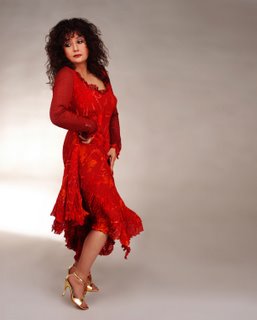 After returning to New York from one of her visits to the South, Maria was invited to join The Even Dozen Jug Band, a group that included John Sebastian, and would eventually end up recording for the Elektra label. "We were paid $65 each for the record and played all of four gigs," Maria says. "Two of them at Carnegie Hall, one in a church and the other on the TV show, 'Hootenanny.' "
After returning to New York from one of her visits to the South, Maria was invited to join The Even Dozen Jug Band, a group that included John Sebastian, and would eventually end up recording for the Elektra label. "We were paid $65 each for the record and played all of four gigs," Maria says. "Two of them at Carnegie Hall, one in a church and the other on the TV show, 'Hootenanny.' "
The Even Dozen Jug Band soon dissolved, not least because most of its members were college-bound, and Muldaur migrated to Massachusetts to check out the Cambridge folk scene. In Cambridge, Maria would end up joining one of the most popular of the then very popular jug bands, The Jim Kweskin Jug Band. Except for the Muldaur connection, Kweskin and his jug band would be all-but-forgotten. The band disbanded in 1968, with several of its members, including Kweskin, joining a cult established by the jug band's ex-harmonica player, Mel Lyman. Lyman's other major claim to fame was for playing a long harmonica solo at the end of the 1965 Newport Folk Festival to the riled crowd streaming out after Dylan's famous electric outburst. But in the late `60s, after ingesting large and regular quantities of LSD, Lyman claimed himself at various times to be: the living embodiment of Truth, the greatest man in the world, Jesus Christ, and an alien entity sent to Earth in human form by extraterrestrials.
The `60s being the `60s, several people agreed with Lyman, including Jim Kweskin, and the band dissolved as Kweskin moved into The Mel Lyman Family. Happily, Maria, and her then-husband Geoff Muldaur, didn't, and they went on to become part of the Woodstock musical community. Geoff would leave Maria – both musically and their marriage – to form the Better Days Band, leaving his last name as his legacy.
"We had a friendly breakup, Maria says, "But I was left weeping in the driveway in Woodstock, a young woman with a five-year old kid. I went to our manager, Albert Grossman, and asked him for a job waitressing in one of his restaurants. I really had no vision of carrying on as a solo artist because for most of my adult life, my career had been tied to Geoffey as the musical mastermind. I was just a cooperative team player."
When Maria told Reprise Records president, Mo Ostin, that the duo he had signed to his label no longer existed,, Ostin's reaction was to offer her the opportunity to make her first solo album.
And of course, that album included the title hit, Midnight at the Oasis.
You can get Maria's full discography from that point at her web site, mariamuldaur.com, so I'm not going to get into that here. What I am going to get into is the knock-out album of Dylan love songs she released this August, Heart of Mine: Love Songs of Bob Dylan. If you haven't heard Heart of Mine, stop this podcast and whatever you're doing right now and go get it… it's one of the best collection of Dylan covers you're going to hear this or any other year. Maria turned 63 this September, but her voice, like Dylan's has aged like the finest wine. Here's Maria Muldaur doing a live version of Heart of Mine, taken from her show on the Woodsongs Old Time Radio Hour. I'll be talking about Wood songs more in the podcast, but first Maria Muldaur…
[Heart of Mine]
Maria Muldaur… there is nuthin' about that woman I don't like.
That live recording came from the Woodsongs Radio Hour, a live audience radio show broadcast over 400 radio stations, and with over 70 full-length shows, including the one with Maria Muldaur available for download. Go get Maria's – Show Number 415 – from Woodsongs.com.
This had been Fred Bals with the Dreamtime podcast – occasional commentary on Bob Dylan's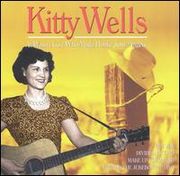 Theme Time Radio Hour. Remember to come by and visit the Dreamtime podcast page. Just put "Dreamtime podcast" into Google and we'll be Number 1 on your hit parade.
Theme Time Radio Hour. Remember to come by and visit the Dreamtime podcast page. Just put "Dreamtime podcast" into Google and we'll be Number 1 on your hit parade.
Closing out tonight's show is Miss Kitty Wells doing the song Maria Muldaur liked to sing at age 5. "It Wasn't God Who Made Honky Tonk Angels" was an "answer song," in response to Hank Thompson's "The Wild Side of Life," Here's the 1952 hit that made Kitty Wells a star.
[It Wasn't God Who Made Honky Tonk Angels]
Posted by
Fred@Dreamtime
at
2:53 PM
0
comments
![]()
Labels: Kitty Wells, Maria Muldaur, Woodsongs Old Time Radio Hour
Monday, October 30, 2006
Episode 19 - That Ol' Black Magic
Direct link to mp3
Subscribe to Dreamtime
Episode 19 - That Ol' Black Magic
We started with example of backmasking, where sounds meant to be played forwards are played backwards.
Sometimes deliberate, sometime only in the ear of the beholder, some bands who may – or may not - have used backmasking include Led Zeppelin, AC/DC, Pink Floyd, Queen, Black Oak Arkansas, Judas Priest, and of course, The Beatles.
The backmasking on the final verse of "Rain" was deliberate, but that led to the 19 and 69 "Paul is Dead" rumor when a Detroit City DJ claimed to have found backward messages in The White
 Album proclaiming McCartney's death. According to True Believers, Paul was replaced with the never-announced winner of a McCartney lookalike contest.
Album proclaiming McCartney's death. According to True Believers, Paul was replaced with the never-announced winner of a McCartney lookalike contest.Hmmm, I wonder if Heather Mills knows that story?
A more recent example of backmasking – or maybe reverse backmasking – was demonstrated by actor Michael Anderson on the Twin Peaks television series. Anderson would phonetically learn reversed speeches, record them, and his dialogue would then be reversed again, giving his speech a stuttering, spooky quality.
[I am the Arm]
Well, our turntables play in only one direction at Dreamtime, and its time to move forward. One of my favorite TV series when I was growing up was Bewitched, which ran from 1964 to 1972, roughly the same period when my hormones were raging at their highest levels. I wanted to be Darrin Stephens, not because the idea of coming up with weird advertising campaigns was attractive (even though it was). And not because the idea of commuting into the city every day and then returning to the 'burbs and a nightly martini sounded cool (even though it did).
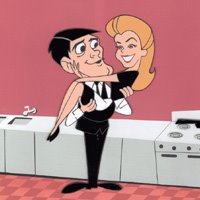 No. I wanted witchy nookie. Specific witchy nookie. Samantha Stephens. I wanted a wife who did wonderful mugging faces and double-takes. I wanted a wife who went "Welllll..." when pressed for an answer she didn't want to give. I wanted a wife who looked great in mini skirts, and even better in Capris. I wanted a wife who could wiggle her nose.
No. I wanted witchy nookie. Specific witchy nookie. Samantha Stephens. I wanted a wife who did wonderful mugging faces and double-takes. I wanted a wife who went "Welllll..." when pressed for an answer she didn't want to give. I wanted a wife who looked great in mini skirts, and even better in Capris. I wanted a wife who could wiggle her nose.Most of all, I wanted to be married to a witch. A specific witch. Hey, Sam, you know what? Darrin's an idiot. Babes, you want to do the nose twitch thing and put us on an island in the Caribbean with hot and cold running money, I'm for it. You want to do lunch in Paris, hang on honey, let me grab my beret. You don't want to do the chores when you know with a sweep of your arms and a zing musical cue everything's done? What, do I look stupid? Do your thing, and come back to bed, baby. There's lots of little Tabithas and Adams to be making.
Give me a witchy theme and I'm a happy camper. And here's Miss Peggy Lee, with that theme…
[Bewitched – Peggy Lee]
A lot of TV show themes had lyrics that were never used, including The Andy Griffith Show, Bonanza, and I Love Lucy
"The Strange Case of Dr Jekyll and Mr. Hyde" was written by the Scottish author Robert Louis Stevenson and first published in 18 and 86. It became one of Stevenson's best-selling works. 120 years later, you can still say Jekyll and Hyde, and everyone will know what you're talking about. Scores of works based on the Jekyll and Hyde theme have been produced, including both versions of The Nutty Professor, the 1996 remake, and Jerry Lewis' original.
In Jerry Lewis' original version, Lewis plays Julius Kelp, a totally social inept college professor who invents a formula that turns him into the cool hipster, Buddy Love. In his first transformation, Buddy turns up a night club populated by college students and proceeds to woo the pneumatic co-ed, Stella Stevens, with a swingin' version of "That Ol' Black Magic."
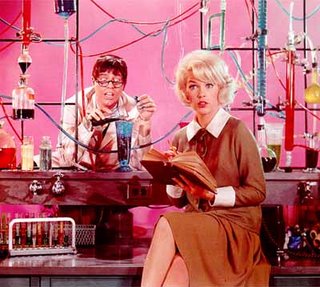
[Jerry Lewis – That Ol' Black Magic]
While Lewis has always denied that it was deliberate, the character of Buddy Love seems to bear more than a close resemblance to Lewis' then ex-partner, Dean Martin.
Me, I've always thought that Buddy Love was probably pretty close to what you'd get if you met the real Jerry Lewis of the `60s.
Next on the turntable is a tune from a group that never existed, The Five Blobs. The Five Blobs is really just one Blob, studio singer Bernie Knee who did all the vocal tracks for the theme song of the classic 1958 monster movie, "The Blob," starring Steve McQueen, and Andy Taylor's girlfriend, Helen Crump.
[Beware of the Blob – The Five Blobs]
 Beware of the Blob was one of the first songs turned out by Burt Bacharach, who teamed up with Mack David to produce it. Burt would later produce many hits with Mack's younger brother, Hal, songs including another tune originally written for the movies, The Look of Love.
Beware of the Blob was one of the first songs turned out by Burt Bacharach, who teamed up with Mack David to produce it. Burt would later produce many hits with Mack's younger brother, Hal, songs including another tune originally written for the movies, The Look of Love.The late `50s and early `60s were a scary period in America, with people facing real monsters like juvenile delinquency, the Atomic Bomb, and of course, the Red Menace.
Communists seemed to be everywhere, including under the bed, as a very young Bob Dylan relates in this song from his Halloween concert…
[Talkin' John Birch]
Y'know, I've been told I do a pretty good young Bob Dylan imitation. It goes like this…
[Fred does Bob]
What do you think?
If you watch The Wizard of Oz carefully, you'll notice that the Wicked Witch tells one of the flying monkeys that she had had sent "a little insect... to take the fight out of them," right before the Flying Monkeys attack Dorothy and her companions in The Haunted Forest.
That "little insect" was The Jitterbug, who would bite each member of the group and make them dance the Jitterbug until they were exhausted and could easily be subdued by the flying monkeys. Here's Judy Garland, Jack Haley, Bert Lahr, and Ray Bolger singing a segment from The Jitterbug...
[The Jitterbug]
The Jitterbug scene was cut from the final movie release, nobody is quite sure why. One theory has it that including a contemporary dance would date the movie too quickly. Another that the producers disliked "show stoppers," feeling that they slowed down what was already an overlong movie. In fact, for awhile, the studio considering removing "Somewhere Over the Rainbow" too, because it was another show stopper.
Glad they didn't.
Well, I see from the Witches' hourglass that, like Dorothy, my time has run out. So, until the next show, have a Happy Halloween and don't let the Jitterbugs bite.
Closing music: Martinibomb and the Coconut Monkeyrocket - Munster Beat!
Posted by
Fred@Dreamtime
at
1:21 PM
0
comments
![]()
Labels: Dean Martin, Halloween, Jerry Lewis, Judy Garland, Peggy Lee, Samantha Stephens, The Five Blobs, The Little Man Who Wasn't There
Monday, October 23, 2006
Episode 18 - High on a Mountain

[Intro]
Direct link to mp3
Subscribe to Dreamtime
Episode 18 – High on a Mountain
[Ollabelle "Elijah Rock" excerpt - from TTRH "Bible"]
Ollabelle is Byron Isaacs, Tony Leone, Fiona McBain, Glenn Patscha and, as Dylan notes, Amy Helm, daughter of The Band's Levon Helm. The group originally grew out of an informal gathering of musicians who came together to play traditional gospel songs at a weekly jam at the East Village bar, 9C.
Ollabelle recorded their debut album in 2004 on spec at a local studio, and the project caught the ear of T Bone Burnett, a man was excellent musical taste, as Dylan says, and who released Ollabelle's self-titled album on his Sony-distributed DMZ label.
Ollabelle now has a second album out, Riverside Battle Songs, as pretty as the first, "a collection of songs of hard times, loss, compassion and hope," as Ollabelle member Fiona McBain describes. Riverside Battle Songs was produced by longtime Dylan sideman, Larry Campbell, and includes a cover of the bluegrass standard "High On A Mountain"—a song written by the band's namesake, Ola Belle Reed, a key inspiration in their formative days.
["High on a Mountain" excerpt]
The research for these podcasts always takes me down unexpected paths, this time from New York City to Grassy Creek, North Carolina. One of thirteen children, Ola Wave Campbell was born on August 17, 1916 in Grassy Creek. In 1936, Ola Belle began performing professionally as a member of the North Carolina Ridge Runners. In the mid `30s, music parks and picnic grounds were popular venues for bluegrass and country music each with a sizable audience and concession money to pay and feed the house band.
"Back home in the summertime we had carnivals - they were the main thing - and little parks," Ola Belle said in an interview. "They were so little that the few times the Ridge Runners played down there, we would be the only show there. I remember one time we came back on a Monday after playing one of these parks.... We played every half-hour all day till the park closed…"
In 1948, Ola Belle and her brother, Alex, teamed up and formed their own country music band, The New River Boys, and became a staple on the radio in the Pennsylvania and Maryland area. In addition to performing, the group sponsored many musical programs at a country music park called New River Ranch, near Rising Sun, Maryland. In 1960, the band transferred to Sunset Park, in West Grove, Pennsylvania, where the group built quite a reputation as one of the quintessential Country Music performance parks. and performed there for the 26 years, broadcasting their own Sunday radio program live from the park.
In addition to performing, the group sponsored many musical programs at a country music park called New River Ranch, near Rising Sun, Maryland. In 1960, the band transferred to Sunset Park, in West Grove, Pennsylvania, where the group built quite a reputation as one of the quintessential Country Music performance parks. and performed there for the 26 years, broadcasting their own Sunday radio program live from the park.
Ola Belle and Alex operated Campbell’s Corner, a general store in Oxford, Pennsylvania which, in addition to general merchandise and groceries, sold country and gospel records and was home base for their own radio show. And in 1949, Ola Belle married Ralph “Bud” Reed, another accomplished local area musical performer.
In 1978, the University of Maryland awarded her with an honorary doctorate of letters for her contributions to the arts and culture of Maryland and the United States. She was also recognized for her historical and musical contributions by The Smithsonian Institute, The Library of Congress and The Country Music Association.
Ola Belle suffered a stroke in 1987 and she was bed-ridden until her death on August 16, 2002. She passed away one day before her 86th birthday. Here's a short excerpt of an interview with Olla Belle, which includes a snippet from her signature song, "High on a Mountain."
[Ola Belle Reed - "High on a Mountain" excerpt]
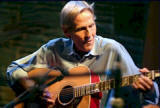 And from Maryland to Woodstock. Hearing Amy Helm naturally made me wonder what's up with her father, Levon, and a quick search on the Web brought be to levonhelm.com and his Midnight Rambles, bimonthly concerts based on old-time Southern medicine shows held at Helm's barn and recording studio in Woodstock. A ticket to the show – if you can get one, the rest of 2006 is already sold out – is $100 bucks, includes chips, salsa and homemade cookies, and you'll hear anything from bluegrass to Springsteen covers from Levon and friends, which in the past have included Dr. John, Emmylou Harris, and Donald Fagen, among any others.
And from Maryland to Woodstock. Hearing Amy Helm naturally made me wonder what's up with her father, Levon, and a quick search on the Web brought be to levonhelm.com and his Midnight Rambles, bimonthly concerts based on old-time Southern medicine shows held at Helm's barn and recording studio in Woodstock. A ticket to the show – if you can get one, the rest of 2006 is already sold out – is $100 bucks, includes chips, salsa and homemade cookies, and you'll hear anything from bluegrass to Springsteen covers from Levon and friends, which in the past have included Dr. John, Emmylou Harris, and Donald Fagen, among any others.
"Dress comfortably and bring a sweater just in case the Catskill air gets chilly, reads the Ramble invitation. We have seating, but if you have a favorite pillow for the floor, that's okay too. Guests are encouraged to bring snack and/or finger foods for the community snack table."
"Every show is a celebration," Helm notes on his web site. And it's a celebration I plan to go to as soon as I can. Expect Dreamtime to be remote podcasting from Woodstock in 2007.
This has been Fred Bals with occasional commentary on Bob Dylan's Theme Time Radio Hour weekly show. And to close out, we have a song from The January 06 Midnight Ramble, a freebie posted on levonhelm.com, if you want to go download your own copy. I wish more bands would do something that.
Sources: Ollabelle.net; Remembering Ola Belle Reed; The Women of Southern Songbirds; Levon Helm's Midnight Ramble
Posted by
Fred@Dreamtime
at
1:49 PM
0
comments
![]()
Labels: Bible, Levon Helm, Ola Belle Reed, Ollabelle, The Band
Thursday, October 12, 2006
Episode 17 - October in the Railroad Earth

[October in the Railroad Earth]
Direct link to mp3
Subscribe to Dreamtime
Jack Kerouac - defest of poets, reading October in the Railroad Earth, accompanied on piano by Steve Allen.
In the "Rich Man, Poor Man" episode of "Theme Time" Dylan includes Kerouac in his list of famous hobos; an appropriate label, as the common definition of "hobo" is "a wanderer who is willing to work."
"I read On the Road in maybe 1959. It changed my life like it changed everyone else's," Dylan notes in an interview. Dylan also mentions Kerouac and On the Road several times in Chronicles. And like with many of us, Dylan's appreciation of Kerouac remained, even as his taste for the Beat lifestyle and characters began to fade away. As Dylan writes, "... [I] lost my interest in the 'hungry for kicks' hipster vision that Kerouac illustrates so well in his book On The Road. That book had been like a bible for me. Not anymore, though. I still loved the breathless, dynamic bop poetry phrases that flowed from Jack's pen, but now, that character Moriarty seemed out of place, purposeless..."
Chronicles. And like with many of us, Dylan's appreciation of Kerouac remained, even as his taste for the Beat lifestyle and characters began to fade away. As Dylan writes, "... [I] lost my interest in the 'hungry for kicks' hipster vision that Kerouac illustrates so well in his book On The Road. That book had been like a bible for me. Not anymore, though. I still loved the breathless, dynamic bop poetry phrases that flowed from Jack's pen, but now, that character Moriarty seemed out of place, purposeless..."
Later in Chronicles Dylan relates a funny story as he and Bono kill a case of Guinness and... "[talked] about things that you only talk about when you're spending the winter with somebody -- talked about Jack Kerouac. Bono knows Kerouac's stuff pretty good. Kerouac, who celebrated American towns like Truckee, Fargo, Butte and Madora -- towns that most Americans never heard of. It seems funny that Bono knows more about Kerouac than most Americans."
As the case is finished off, Dylan recommends that if Bono wants to see the birthplace of  America, he should go to Alexandria, Minnesota. Dylan details an itinerary for Bono, telling him to "follow the river through Winona, Lake City, Frontenac," a road trip that if Bono ever took would involve a drive up Highway 61.
America, he should go to Alexandria, Minnesota. Dylan details an itinerary for Bono, telling him to "follow the river through Winona, Lake City, Frontenac," a road trip that if Bono ever took would involve a drive up Highway 61.
And, of course, Kerouac was a source for Dylan. Kerouac's novel Desolation Angels was published in May 1965, and Highway 61 Revisited recorded in August 1965. "Desolation Row" and "Just Like Tom Thumb’s Blues" include quotes from Desolation Angels, including the phrases "a perfect image of a priest," "her sin is her lifelessness," and "Housing Project Hill."
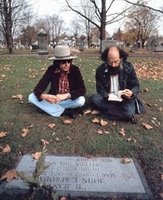
Kerouac died on October 21, 1969 at age 47. Allen Ginsberg and Dylan visited Kerouac’s grave at Edson Cemetery, in Lowell, Massachusetts during the Rolling Thunder tour of 1975, a pilgrimage chronicled in the movie Renaldo and Clara. They read choruses from Kerouac’s Mexico City Blues and Ginsberg asked Dylan how he knew Kerouac’s poetry. Dylan replied, "Someone handed me Mexico City Blues in 1959 and it blew my mind. It was the first poetry that spoke my own language."
This has been Fred Bals with the Dreamtime podcast - occasional commentary on Bob Dylan's Theme Time Radio Hour weekly show. Until next time, may you dream well during October in the Railroad Earth.
Sources: Kerouac Corner, with Dave Moore and friends. The invaluable Boblit site. And don't miss the wonderful "Highway 61, Visited" NY Times article where the writer and friend take a road trip based on Dylan's directions to Bono.
The opening and closing recordings are from The Jack Kerouac Collection, a complete collection of the three jazz/poetry albums Kerouac cut. Highly recommended.
The two October foliage photos are courtesy P.W. Bals.
Posted by
Fred@Dreamtime
at
10:15 AM
0
comments
![]()
Labels: Allen Ginsberg, Bono, Jack Kerouac, Rich Man Poor Man
Friday, October 06, 2006
Episode 16 – "Gene Vincent said, 'Bubba, let's go on tour'"
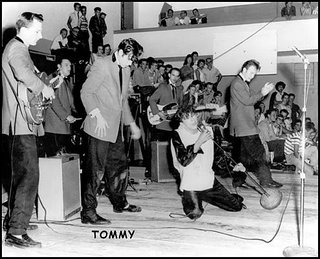
[Intro]
Direct link to mp3
Subscribe to Dreamtime
This is the Dreamtime podcast - occasional commentary on Bob Dylan's Theme Time Radio Hour weekly show.
Episode 16 – "Gene Vincent said, 'Bubba, let's go on tour'"
[High School U.S.A. excerpt]
Written by a Norfolk Virginia record store owner named Frank Guida, Tommy Facenda's "High School U.S.A." was on the Billboard Charts for 13 weeks in 1959, peaking at number 28. Tommy's page at the Rockabilly Hall of Fame web site says Guida originally wanted a black doo-wop group to do the number, but then had visions of Facenda becoming the next Frankie Avalon with the song.
The original version of "High School U.S.A."– on Guida's own Legrand Records label - names various Virginia-area high schools. Guida convinced Atlantic to pick the song up, and someone – maybe someone at Atlantic, maybe Guida – realized the idea could be extended for schools across America. So, Tommy went back and re-recorded versions using school names in different cities. How many versions? No one seems to know, maybe 25. Maybe 28. Maybe 30. Maybe as many as 40… or 50.
Tommy Facenda says, "The magic number they seem to come up with is 28. There were more. They might not all have been released, but I cut a copy for every state in the U.S.A. Maybe 28 were released, but I know what I cut. It was just about the most awful thing to go through…"
Indeed, because Tommy didn't simply re-record the lyric listing school names, each master was recorded from beginning to end. Or maybe not. The page at the Rockabilly Hall of Fame – which contains articles from different writers - contradicts itself several times. One section says 40 versions. Another says 28. One section says that Tommy completely re-recorded each version. Another says Tommy sang the relevant verse over and again to add the name changes… which sounds a heckuva lot more likely.
In either case, it must have been an effort. The Cincinnati version of High School U.S.A." required Tommy to sing out nearly 30 high school names. With even 28 versions, he probably catalogued somewhere between 500 to 700 schools during the recording sessions.
And imagine the problems of touring. As Tommy says, "Everyone else in the tour package could just sing their same hits all the time. I had to study the upcoming town's high school name list using a pen light on the bus. If I forgot the names, I'd just sing the original Virginia version."
Born in 1939, Tommy Facenda joined Gene Vincent's "Blue Caps" band in 1957 as a background singer and dancer, and was immediately nicknamed "Bubba." Usually on Vincent's right in band publicity shots, you can spot Tommy in full `50s coolness with upturned collar, slicked-backed hair, and JD sideburns. During concerts, Tommy would show off his patented "Facenda Freeze" when, during a Johnny Meeks guitar solo and with Vincent rolling in full frenzy on the floor, Facenda would begin shaking from head to foot as if totally overcome by the Dark Demons of rock-and-roll.
It was a show-stopper.
Tommy's run with Vincent was short. By `mid-58 he had left the Blue Caps to pursue a solo career.. not having much luck until "High School U.S.A." became a hit for him. That put Tommy in demand and he ended up on tour bills with Jackie Wilson, Connie Francis, Annette Funicello, Bobby Rydell, Frankie Avalon, and Fabian, among others, singing out the names of local high schools one city at a time.
But that hit would also be the peak of his music career, and after a stint in the Army, Tommy Facenda headed back to Portsmouth, Virginia, where he had been born and raised. He took a job with the local Fire Department, stayed with that until his retirement, and then worked as a part-time hospital security guard.
He may be doing that in Portsmouth still, making the rounds of the calm hospital corridors, and maybe on the quiet nights suddenly stopping and slowly stretching out his arms, lifting on his toes… shaking from head to foot as if possessed by the Demons of Rock n Roll.
I kind of hope so.
This has been Fred Bals – Chadwick School, Palos Verdes, California, 19 and 71, with the Dreamtime podcast - occasional commentary on Bob Dylan's Theme Time Radio Hour weekly show.
Dreamtime is not associated with XM Radio or Bob Dylan, and had nothing to do with that cherry bomb in the girl's bathroom. Until next time, dream on.
Posted by
Fred@Dreamtime
at
10:51 AM
3
comments
![]()
Labels: Gene Vincent, School, Tommy Facenda
Thursday, September 28, 2006
Episode 15 – I Ran at Bakersfield

[Intro]
Direct link to mp3
Subscribe to Dreamtime
[James Dean - Drive Safely]
Episode 15 – I ran at Bakersfield
This is the Dreamtime podcast - occasional commentary on Bob Dylan's Theme Time Radio Hour weekly show.
Sometimes you write the show, and sometimes the show decides to write you. This is one of those shows. This Saturday is September 30th, 2006. Fifty-one years ago, on September 30th, 1955, James Dean died.
I didn't remember that until a few days ago. The date – and the accident – used to be a lot more important to me some 30-odd years back. In the early '70s, I spent the good part of one Fall season driving back and forth between Northern and Southern California, down the Grapevine on Route 5 from Los Angeles, through the San Joaquin Valley and back to the college I was in the long, slow process of leaving.
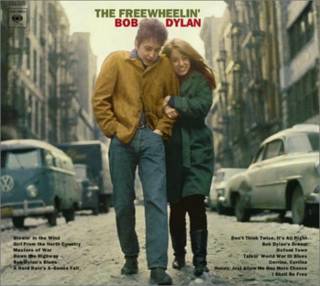 There was a girl in Los Angeles. There's always a girl somewhere in every story. She was in the long, slow process of leaving me too, but I didn't know that then. So every Thursday I would take the Volkswagen, loaded with whatever passengers I could find who were willing to pony up $10 bucks for a roundtrip to LA and back and leave around 11 or so at night to go stay with my girl over the weekend. On Sundays, I'd make the reverse trip… 350 miles back.
There was a girl in Los Angeles. There's always a girl somewhere in every story. She was in the long, slow process of leaving me too, but I didn't know that then. So every Thursday I would take the Volkswagen, loaded with whatever passengers I could find who were willing to pony up $10 bucks for a roundtrip to LA and back and leave around 11 or so at night to go stay with my girl over the weekend. On Sundays, I'd make the reverse trip… 350 miles back.
On one trip back – by myself that time – I detoured off 5 after passing Bakersfield and headed west on Highway 46, pulling off at the intersection of 46 and 41. It was a little before six pm on September 30th, 19 and 71.
Sixteen years earlier, Dean's Porsche Spyder flew over the road I had just traveled, bearing down like a freight train on the downgrade to a bump-in-the-road town called Cholame. At the intersection of Highways 46 and 41, Dean would collide with a Ford Tudor, driven by a 23-year-old with the unlikely last name of Turnupseed. It was 5:45 in the early evening. The sun was just setting.
Turnupseed would survive the accident and live for another 40 years. He would never speak publicly about what had happened. Dean's one passenger also survived. Dean lived for a few moments after the crash, but was pronounced Dead On Arrival at Paso Robles Hospital.
Rebel without a Cause would premiere about a month later.
We all make pilgrimages. In 1988, Dylan, with an entourage of 15 in tow, visited the farm that Dean grew up on, in Fairmount, Indiana. "It was 1 or 2 o'clock in the morning,” said Marcus Winslow, one of Dean’s cousins. “He'd had a concert in Indianapolis, and he came with a bus to Fairmount. He came out here for a few minutes. ..."
That was probably the morning of July 16th, 19 and 88, the morning after Dylan finished a show at the Indiana State Fairgrounds during what would become the first year of the Never Ending Tour. As an aside, Dylan mentions in the liner notes of World Gone Wrong that the Never Ending Tour actually ended three years later in 1991, to be followed by a succession of others, including The Money Never Runs Out, The Southern Sympathizer and the Why Do You Look at Me So Strangely tours.
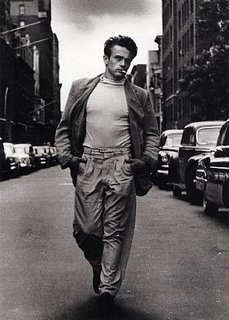
No word on what the current one is called, although I’m holding out hope that its name is The Search for Rejection tour in honor of Modern Times.
In 1955, Bob Dylan was 14 years old. Like hundreds of other teenagers he would see Rebel multiple times, and bought Rebel's iconic red jacket… just like James Dean’s.
During the 1963 cover shoot for The Freewheelin' Bob Dylan, Dylan reportedly wanted to create Roy Schatt's 1954 photo of James Dean walking down West 68th in New York City. The Freewheelin' photo that would eventually be the cover uses Jones Street in Greenwich Village, a one-block street connecting West 4th and Bleeker, as its backdrop.
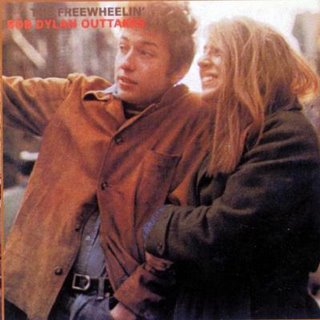 At least one other Don Hunstein photo from the same session has surfaced. Used as the cover art on The Freewheelin' Bob Dylan Outtakes bootleg, the picture also features Dylan's girlfriend at the time, Suze Rotolo, braced on his arm as he strikes an even more Dean-like pose.
At least one other Don Hunstein photo from the same session has surfaced. Used as the cover art on The Freewheelin' Bob Dylan Outtakes bootleg, the picture also features Dylan's girlfriend at the time, Suze Rotolo, braced on his arm as he strikes an even more Dean-like pose.
We all emulate our heroes.
On the 50th anniversary of Dean's death, the state of California put up a sign at the intersection, naming it the James Dean Memorial Junction. If you travel about a quarter of a mile west, you'll find a memorial put up in 1977 by a Japanese Dean fan. It's engraved with Dean's name, date of birth and death, an infinity symbol, and what was reportedly Dean's favorite quote, "What is essential is invisible to the eye," from The Little Prince.
Back in the early `70s, none of that was there to see at the junctions of 41 and 46, just a lonely, dusty patch of California road. I sat on the hood of my car for awhile, watching the sun go down. And I got back in the VW, pulled onto the road, blinded then by the explosion of the sunset's glare, not able to see a thing.
And a car came out of the sunset light, engine screaming, horn blaring, swerving inches from my left bumper, and then gone.
I think it was a silver Porsche. It looked like a Porsche. But except for a lone, dark patch of rubber from its braking, there was nothing left to see.
I had stalled the VW in my fright. I started it up again and drove on. In a year I'd be in the Army, and on the road that would eventually lead me here, in my kitchen in New Hampshire, looking out the window at golden Fall light, writing this, in the year of our Lord, 2006.
[Rebel without a Cause theme]
This has been Fred Bals with the Dreamtime podcast, occasional commentary on Bob Dylan's Theme Time Radio Hour weekly show and occasionally commentary on other dreams. I'll be at Podcast Expo in Ontario, California on September 30th. If you're in the neighborhood, come by and say hello.
I'll be the guy wearing the red jacket... just like James Dean.
The opening Gig Young interview with James Dean on automobile safety and the closing Rebel theme were both taken from the beautifully produced Rebel without a Cause 2-disc DVD set. If you haven't seen Rebel - or haven't seen it in awhile, go watch it. The background music - provided tonight from the PodShow Podsafe Music Network. Check it out at 'music.podshow.com. The artist is nezecus.
Visit the Dreamtime Store
Posted by
Fred@Dreamtime
at
8:45 PM
0
comments
![]()
Labels: Cars, Devil, James Dean
Tuesday, September 19, 2006
Episode 14 - Working for the Yankee dollar
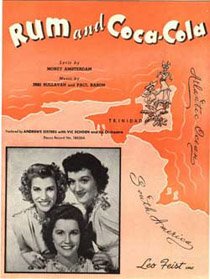
[Intro]
Direct link to mp3
Subscribe to Dreamtime
This is the Dreamtime podcast - occasional commentary on Bob Dylan's Theme Time Radio Hour weekly show.
If you follow Bob Dylan, and I would assume you do if you listen to Dreamtime, you're probably aware of last week's NY Times article about Dylan reworking several lines from various poems by an all-but-forgotten 19th century poet, Henry Timrod, into the lyrics of songs from Modern Times.
I think while it's obvious Timrod is a source, I don't think there's much to get excited about, especially if you go to the trouble to compare Timrod's work versus Dylan's work. The lines and phrases are used in completely different ways to produce completely different works, in my opinion. I'm not going to weigh in on the debate past that except recommending - if you're interested - that you go check the lines in question both in their original form and in Dylan's version, as I did.
Timrod's poems are reproduced on many internet sites and there's an excellent site annotating Modern Times' lyrics that's worth your while to visit. I'll link to those sites in this episode's show notes.
I bring all this up only because I recently did a "sources of 'Love and Theft,'" in episode 12, and this week's episode is on the famous plagiarism story behind "Rum and Coca-Cola." Fwiw, I had both episodes planned long before the Modern Times story, and I don't want my listeners thinking I'm promoting some sort of hidden agenda of criticism against Dylan.
As with "Love and Theft," Modern Times is filled with references, allusions, sampling, and reworking from both ancient and contemporary sources. And personally, I find locating Dylan's sources a fascinating and enlightening exercise. And, as with "Love and Theft," I look forward to discovering the sources behind Modern Times. 'Nuff said.
On to this week's episode 14 - Working for the Yankee dollar
[Andrews Sisters - "Rum and Coca-Cola"]
"Rum and Coca-Cola" has a very twisty history. A huge hit for the Andrews Sisters, selling over seven million copies after its release in 1945, the melody apparently began life as a Martinique folk song sometime in the 19th century. In 1906, Lionel Belasco, a Trinidadian pianist, composer and bandleader, used that melody and added lyrics and the title, "L'Année Passée."
As Dylan mentions in an introduction to another song, Calypso often acts as a cultural meme, reporting important social and political news - and always opinion - to people without access to newspapers, radios, or television. "L'Année Passée", or "Last Year," in English, tells the story of the downfall of a daughter of a prominent Trinidad family, who ends her days as a prostitute walking the Trinidad streets.
["L'Annee Passee" excerpt]
Last year [the song goes], Last year I was a little girlLuckily for Belasco, even though he never recorded the song, nor apparently put the lyrics to paper until the 1940s, he did submit "L'Année Passée" among several other songs to a publisher, who copyrighted it in 1943.
Living with my dear mother at home;
This year I am a woman though,
On the streets you will find me roam.
Sometime between 1942 and 1943, Rupert Westmore Grant, a Calypso singer known professionally as "Lord Invader," composed the words to "Rum and Coca-Cola." Lord Invader's version, in the tradition of Calypso, is a complaint about American G.I.'s ah, "relationships," with the local women who, as the song goes, "saw that the Yankees treat them nice / and they give them a better price." In fact, the final stanza of the Lord Invader version relates a bride running away with a US soldier lad, driving her "stupid husband" "staring mad" in the process.
The lyric was copyrighted in Trinidad in February of 1943 and Lord Invader began to sing the song publicly in March using a reworked version of "L'Année Passée" as the melody. In court, Grant claimed that he hadn't tried to copyright the music in the belief that it belonged to Belasco, as it did.
In September of 1943, Morey Amsterdam arrived in Trinidad as an entertainer for the U.S.O. He stayed for about a month, during a period when Lord Invader's "Rum and Coca-Cola" was at the peak of its popularity. Amsterdam's testimony about how he supposedly wrote the song was rife, in the court's terms, with contradictions and improbabilities. He claimed never to have heard the Lord Invader version and came up with the idea for the song when he heard a soldier sing the words, "Rum and Coca-Cola kill the Yankee soldier" to the melody of "It Ain't Gonna Rain No More." That inspired him, Amsterdam claimed, to write the "Rum and Coca-Cola" lyrics, and put the song into his show, still using the "Ain't Gonna Rain No More" tune.
Back in New York, Amsterdam reportedly offered the song to a now long-forgotten singer, Jeri Sullivan, who commissioned Paul Baron, she said, to write the music. In testimony equally as torturous as that offered by Amsterdam, Baron claimed to have based his music - mysteriously identical to that of Belasco's - on a Spanish melody and on a song he called "King Jaja." Baron was possibly smoking King Jaja at the time, since he couldn't identify that song, its origin, or who had sung it.
In any case, if you're a collector of obscure Andrews Sisters items, you might want to search out one of the first 200,000 singles of "Rum and Coca-Cola," listing Amsterdam as sole composer of both lyrics and music. For reasons unknown, but probably having something to do with the fact that "Rum and Coca-Cola" was a mega hit, Jeri Sullivan and Paul Baron quickly consulted a lawyer, and in the credits after 1944, Amsterdam, Sullivan, and Baron are all listed as co-composers and copyright holders.
Maybe because of bad karma, the Andrews Sisters version of the song had a troubled career, even though a million-selling record. The sisters were recording two songs for Decca, and finding they still had 30 minutes of session time, they decided to record "Rum and Coca-Cola," even though they had only seen the song for the first time the night before. Patty Andrews recalled, "We hardly really knew it, and when we went in we had some extra time and we just threw it in, and that was the miracle of it. It was actually a faked arrangement. There was no written background, so we just kind of faked it."
Kind of appropriate, don't you think? While the record would prove a enormous hit, only surpassed by The Tennessee Waltz and White Christmas, it was banned from the radio. First, because it mentioned rum; and at that time you couldn't mention liquor on the air. Then, there was the "Coca-Cola" problem. Free advertising in the eyes of Coke's competitors.
And, that didn't even get to the lyrics, which even in Amsterdam's sanitized version, made it pretty obvious that the mother and daughter's work for the Yankee dollar meant more than oiling up the soldier's weapons… if you get my drift. Maybe that's why the Andrews never included "Rum and Coca-Cola" in any of their films.
In 1947, the copyright holder of Lord Invader's original lyrics - not Lord Invader himself - prosecuted a successful infringement case against Amsterdam and the US publisher of "Rum and Coca Cola." And in 1949, the copyright holder of "L'Année Passée," - who wasn't the composer, Belasco - successfully sued the publisher again.
Reportedly, both Belasco and Lord Invader eventually received six-figure payments in settlement, I assume from the copyright holders who had won the cases. But ironically, the infringers would retain their copyright to "Rum and Coca-Cola." And as Dylan says, people still think Morey Amsterdam wrote the song. In fact, if you go to Amsterdam's page on the International Movie database site, you'll see "Rum and Coca-Cola" listed in his credits.
So, ask yourself, who wrote "Rum and Coca-Cola?" Morey Amsterdam, U.S. copyright holder, who slightly changed some lyrics to a song he heard in Trinidad? Lord Invader, who put new lyrics to a song written by Lionel Belasco in the early 1900s? Lionel Belasco, who adapted his music from a folk song from the 1800s?
And how far back does the thread stretch from there? Who originally wrote the music that would evolve into "Rum and Coca-Cola"?
[Lord Invader - "Rum and Coca-Cola" excerpt ]
This has been Fred Bals with the Dreamtime podcast - occasional commentary on Bob Dylan's Theme Time Radio Hour weekly show. Dreamtime is not associated with XM Radio or Bob Dylan. No names were changed to protect the innocent in tonight's podcast. Until next time, hold tight on to your dreams.
Sources: Lord Invader - "Rum and Coca Cola" excerpt; Legal opinion by New York District Judge Simon Rifkind, who ruled that the music to "Rum and Coca-Cola" infringed upon the copyright to Lionel Belasco's song, "L'Année Passée."; The Mudcat Cafe, a website devoted to folk musicology, has a forum thread that discusses the song, with postings that include the full lyrics of both the Lord Invader and Morey Amsterdam versions, as well as the lyrics to "L'Année Passée" and some alternative, more ribald lyrics for "Rum and Coca-Cola" that Amsterdam reportedly sang when entertaining troops. ("She wear grass skirt but that's O. K. / Yankee like to hit the hay.") Links via Wikipedia which provides an overview of the "Rum and Coca-Cola" story.
Posted by
Fred@Dreamtime
at
4:13 PM
2
comments
![]()
Labels: Andrews Sisters, Drinking, Hentry Timrod, Lionel Belasco, Lord Invader, Morey Amsterdam, Rum and Coca-Cola


